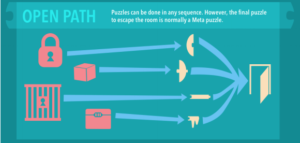In the previous lesson, we have been over the pros and cons of creating puzzles for your escape rooms, which follow a linear path. In this lesson, we will introduce the second path described by Nicholson (2015): the open path.
The open path is composed by puzzles that can be solved in any order (Wiemker et al., 2015). All puzzles, except the last one, are available to interact with from the beginning of the game. Each player can choose on which one to focus, has the possibility to change and come back to it at a later stage. The last puzzle – often called metapuzzle – is usually blocked and cannot be worked on until the other puzzles are completed. Clues to solve it usually derive from the previous given answers. (Wiemker et al., 2015). The solution of each initial puzzle contains parts of a new enigma that needs to be combined for the metapuzzle to be resolved.
Illustration
The following infographic from Wiemker et al. (2015) might help you visualize what we mean by open path.

From the start, we have four different puzzles: a lock, a box, a gated door and a chest. All of them need to be opened at their own time and separately. An enigma is required for each one of them. Each usually contains a new puzzle or a piece of the solution for the metapuzzle – here a part of a key –all of which have to be combined to open the exit door.
Hereafter, two examples of a metapuzzles that could be used in STEM:
- In mathematics, we can imagine parts of an equation that would need to be combined then solved to open a lock on the exit door.
- In chemistry, we can imagine a cut molecule which would need to be reconstituted. The chemical formula could be the code to open a cryptex containing the key to the door (e.g. NaCl for sodium chloride or C6H12O6 for glucose).
A cryptex is a portable vault that first appeared in 2003 in Dan Brown’s Da Vinci Code (Cryptex, 2019). It is easier to master as it appears. It can be created at home with cardboards and paper, providing that you have some time to spare. (Nadam, 2019) Plastic premade versions can also be purchased online. You will only be required to set it up.

Pros
This path is not the most widespread around the world. Nicholson (2015) found it in only 13% of the 175 surveyed facilities. However, it is more adapted to educative escape rooms than linear paths are. As we mentioned before, educational escape rooms usually group up to 10 students per session, which is high number of a number for the linear structure to prove effective. Instead, the open path allows for more people to be involved in the solving process at the same time. In Wiemker’s et al. example above, two students could try solving the puzzle associated with the lock, while three others attempt to open the chest, and so on.
Firstly, this will foster collaboration:
- within small groups working on the initial puzzles
- required between small groups to solve the final puzzle. They will need to share their ideas, discoveries and explain their thought process.
Additionally, if one group finishes its puzzle before another, the students of the first group could help their classmates with solving their puzzle. If two groups are stuck, even after hints are given, they could switch puzzles and offer a fresh perspective.
Furthermore, the open structure still offers the advantage of being easy to implement. In some cases, it might be even easier than the linear path structure, as it does not require a reflection on the puzzle sequencing.
Cons
The first con concerns the difficulty.
First, the open path will be more difficult to handle for unexperienced players, as this puzzle structure lacks a clear entry point, as well as a visible sequence and logic. It could create confusion among your students, especially those at a young age.
However, this problem can be solved with a clear explanation from the game master / educator prior to the game, or with some clues, given either at the very beginning or after several minutes of visible blockage.
Second, open paths could seem too easy and uninteresting for students who already played in professional Escape Game facilities. Open paths remove the possibility for surprises, as everything is available from the start. Experienced players will know what to do. Yet, uncertainty and discovery are two essential variables of Escape Rooms. Not having a succession of puzzles could therefore reduce the feeling of accomplishment and create boredom.
Taking this context into account, we advise you to use the open path in the middle of your creation journey, after having tested the linear path. If it fit your needs and the ones of your students, keep at it. If it does not, gradually move away from it as you gain in confidence.
We will detail an additional path in grain 15. It will give you a new solution – more difficult, yet more engaging – to avoid the problems mentioned above and to create an elaborate puzzle sequence.

